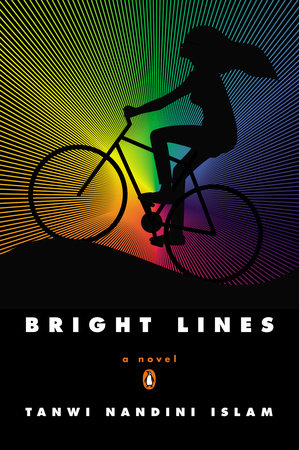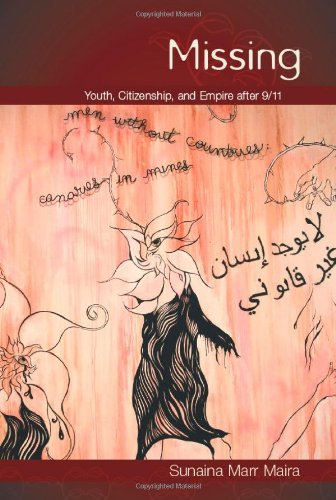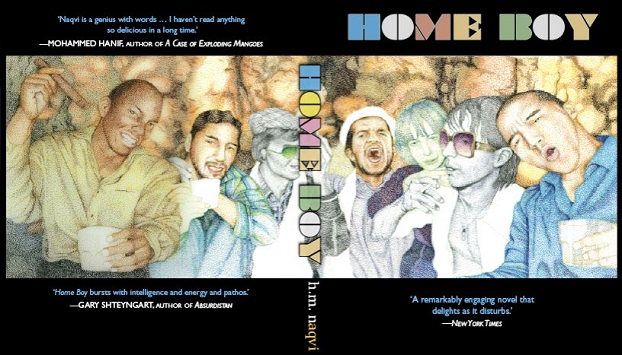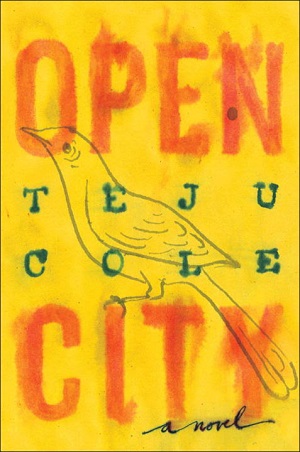Welcome back to The Aerogram Book Club, where Book Club editor Neelanjana Banerjee brings together writers and thinkers to discuss South Asian books of significance. Join in with your thoughts in the comments after reading the discussion with Banerjee and Nilanjana Bhattacharjya, an ethnomusicologist and writer on South Asian music and popular film.

In Tanwi Nandini Islam’s debut novel Bright Lines (Penguin), we meet the Saleems, a Bangladeshi family living in Brooklyn. Anwar and Hashi adopted Hashi’s brother’s daughter Ella, when her parents were murdered after the Bangladeshi Liberation War. Ella, uncomfortable in her body and suffering trauma-induced visions at dusk, is home from Cornell for the summer and in love with her cousin Charu — Anwar and Hashi’s real daughter. Charu can’t wait to leave for college, but in the meantime, plans to spend the summer making out with her boyfriend Malik.
Set in the hot, turbulent summer and winter of 2003, the novel explores the desires and secrets of all of these characters until a violent act takes them back to Bangladesh to dig into the past. The novel was nominated for a Center for Fiction First Novel Prize, and Islam continues her creative work at HiWildflower, a handmade botanical products line.
 Neelanjana Banerjee: When I first read the description of Tanwi Nandini Islam’s Bright Lines, I got insanely excited. I couldn’t wait to lay my hands on this book because I am always searching for a South Asian American coming-of-age story that feels relevant to my own life. I feel like South Asian American writers often pivot to stories of first-generation immigrants, or tell the stories of those in the homeland. I was painfully disappointed in Gogol, the protagonist of Jumpha Lahiri’s The Namesake, for his obsession with white privilege, and his myopic issues around his identity.
Neelanjana Banerjee: When I first read the description of Tanwi Nandini Islam’s Bright Lines, I got insanely excited. I couldn’t wait to lay my hands on this book because I am always searching for a South Asian American coming-of-age story that feels relevant to my own life. I feel like South Asian American writers often pivot to stories of first-generation immigrants, or tell the stories of those in the homeland. I was painfully disappointed in Gogol, the protagonist of Jumpha Lahiri’s The Namesake, for his obsession with white privilege, and his myopic issues around his identity.
The part of Bright Lines that I was most excited by was that we were going to see urban, Bangladeshi characters interact with other characters of color, not just other South Asians. And Bright Lines delivers: from the jump we come across Rashaud Persaud, a Guyanese street hawker who supplies family patriarch Anwar with weed treats (more about Anwar as the first stoner South Asian American immigrant in literature later), then there’s Charu’s boyfriend Malik — a black hipster skateboarder who works for Charu’s uncle, Maya — the Moroccan-Egyptian girl in a hijab on the run from her strict father Sallah S, Ramona Espinal — the Mexican tenant that Anwar falls for, and more. Yes, more.
And in the second half of the book, when the family travels to Bangladesh, Islam continues her exploration of diversity by bringing to life Bangladesh’s minorities — tribal peoples with secret connections to the family. Islam’s even bold enough to introduce a new POV, Hashi’s much younger brother Stalin gets his say for the first time on page 197!
So, obviously, these characters can’t all be developed. Even in the family, Anwar and Ella get center stage, with Charu, then Hashi getting the next closest treatment. I admire Islam’s vision and that she writes New York and Bangladesh the way I often feel in these places (or at least, Kolkata): manic, unable to keep everything straight.
“I admire Islam’s vision and that she writes New York and Bangladesh the way I often feel in these places (or at least, Kolkata): manic, unable to keep everything straight.”
Sometimes, this novel felt like a piece of theater to me because some of the settings were so detailed: the Saleems’ house on 111 Cambridge, which Anwar bought and renovated after it had been a Crack House; the garden at the center of the house where Islam brings forth all her knowledge on plants to turn into a magic place, Charu’s room littered with scraps of fabric with the soundtrack of the sewing machine running. Even the first scene, when Anwar leaves his natural goods store and sees Maya climbing out of her father’s home in a hijab — what a wonderful image to set this novel in motion.
But I was most invested in Anwar and Ella — and they were both surprising characters. Anwar, the family patriarch, was at first familiar to me as a Bengali: an absent-minded, brilliant, melancholy man obsessed with the past. This is a pretty recognizable Bengali trope, wouldn’t you say Nilanjana? But then he starts turning.
I love that Anwar is non-traditional, a dreamer, a maker of plant potions and an imbiber of plant medicines. I appreciate that in this novel, Anwar — along with facing secrets and traumas from his past as a soldier in the Liberation War — is facing the temptation of another woman, a real threat to his life. Islam imbues Anwar with desires and faults and bad habits and ghosts, and this made him the center of the novel for me — his richness. I was much more invested in Anwar’s relationship with Hashi, and the threat of another woman, than I was in Charu’s heartbreak over Malik, or even Ella’s eventual heartbreak over Maya.
Speaking of Ella, I found her fascinating as well. Not only is she dealing with being an adopted girl, but also processing the trauma of her parents’ violent death. She is in love with Charu, but then not. I love that the novel is not afraid to traffic in all kinds of desires, whether it be between cousins, distant nieces and nephews, tenant and landlord.
“I love that the novel is not afraid to traffic in all kinds of desires”
And one of the storylines that I found most compelling was Ella coming to terms with her sexuality and her identity as a transgender man. In fact, like Anwar, I would have read a whole novel focused on this, and sometimes I was frustrated that this story was buried under all the other issues that Ella was dealing with. Which characters did you find most compelling?
 Nilanjana Bhattacharjya: The seemingly endless stream of characters introduced in the first few chapters overwhelmed me the first time I tried to read the book, even as the idea of them delighted me. Like you, I tire of the standard middle class Indian American narrative where characters enact their desires and identities against the standards set by their parents and communities. (I love that Islam takes the stereotype of the noble Bengali romantic revolutionary to task here, and that one of the ways she accomplishes that is by turning Anwar into a pothead!)
Nilanjana Bhattacharjya: The seemingly endless stream of characters introduced in the first few chapters overwhelmed me the first time I tried to read the book, even as the idea of them delighted me. Like you, I tire of the standard middle class Indian American narrative where characters enact their desires and identities against the standards set by their parents and communities. (I love that Islam takes the stereotype of the noble Bengali romantic revolutionary to task here, and that one of the ways she accomplishes that is by turning Anwar into a pothead!)
Islam complicates the standard narrative in an almost dizzying number of ways: through unconventional sexualities and gender identities, imaginings of Muslim identity, friendships across different racial, ethnic, and class lines and diasporic communities, and of course, the return to Bangladesh in the second half of the book, which made much more sense to me. I sympathize with why she did all of this, but like you, I find myself distracted by many of these characters as I tried to concentrate on Anwar and Ella in the first half, and the house.
As the house and other minor characters drifted into the past in the second half, Ella and Anwar’s stories finally came into focus. I was perhaps less bothered by Ella’s issues overshadowing her transgender transformation because Hashi and Anwar’s claiming of El as the reborn brother and son worked for me, even if I can’t explain it.
“I…especially appreciated the messy richness of South Asian histories here that rarely get acknowledged in diasporic narratives…”
I just spent a week in northeast India, from which I looked out across the border into Bangladesh and Bhutan. I therefore especially appreciated the messy richness of South Asian histories here that rarely get acknowledged in diasporic narratives that surgically separate the homeland from the new world and deny that some of us live between and among many borders, which assumes that we are even included within them at all — from the stories of the Chakma and other indigenous groups in the Chittagong Hill Tracts to the Bengali and Assamese suppression of the Khasi to the Khasi’s eventual grasp of power in Meghalaya and their continuing hostility against Bangladeshis and Muslims today.
 Neelanjana Banerjee: Nilanjana, as we’ve been having this conversation over several months, I feel like it has allowed me to go back and dive into sections of Bright Lines various times, and it is a book that asks that of the reader, and doing so, I was rewarded. This is a book to linger over, to begin and then put down and then pick up again, months later and carry with you and remember and be surprised by.
Neelanjana Banerjee: Nilanjana, as we’ve been having this conversation over several months, I feel like it has allowed me to go back and dive into sections of Bright Lines various times, and it is a book that asks that of the reader, and doing so, I was rewarded. This is a book to linger over, to begin and then put down and then pick up again, months later and carry with you and remember and be surprised by.
In that way, it is truly Anwar’s story — Anwar, who has the non-linear mind of a long-time marijuana connoisseur. How delightful to be reading and thinking about this book as you actually traveled to those corners of South Asia that the book discusses. I was intrigued by the inclusion of the Khasi people in this book, and thought it was especially powerful and astute to talk about tribal oppression here, and think about how that echoes across to Brooklyn and the lives of the family and people there.
“She said that she considers the book to be a post-9.11 novel, even though it doesn’t delve specifically into post-9.11 backlash issues…”
I saw Tanwi read from the book and discuss it here in Los Angeles, and something she said really struck me. She said that she considers the book to be a post-9.11 novel, even though it doesn’t delve specifically into post-9.11 backlash issues of violence, or INS Special Registration, etc., etc. Instead, she felt like her characters and their issues — the fact that Anwar and El were dealing with the fall-out from a war — added to the general unease of what was going on in New York and across America at the time (the novel is set in 2003).
https://twitter.com/kima_jones/status/662829139661983744
I think this was a really fascinating choice, and a truthful one, meaning that post-9.11 politics affected everyone living in America, especially in New York, but not necessarily through hate crimes or the Patriot Act. She could have gone there, but instead she chose to explore more complicated personal relationships and violence. I am thinking specifically of Sallah S, who is depicted both gathering and organizing within the Muslim community in Brooklyn, but also as an abusive father and husband, and ultimately a perpetrator of violence against the Saleem family.
I bring this up because I think post-9.11 issues are a rich area for South Asian American writers and I am curious as to what your take on the way Bright Lines addresses these issues are, and what are some of your other favorite/go-to books about post 9.11 America by South Asian writers. (Homeboy by H. M. Naqvi is mine.)
 Nilanjana Bhattacharjya: Neelanjana, this is indeed a book to revisit. I look forward to reading it again and better recognizing the many strands that connect the first and second halves of the book. Seeing the Khasi hills while reading this novel made me confront how difficult it is to narrate your history if it happens to fall between (or underneath) the borders of the nation-state, and the inherent violence associated with asking such people to identify themselves in relation to the nation-state — a single-nation state.
Nilanjana Bhattacharjya: Neelanjana, this is indeed a book to revisit. I look forward to reading it again and better recognizing the many strands that connect the first and second halves of the book. Seeing the Khasi hills while reading this novel made me confront how difficult it is to narrate your history if it happens to fall between (or underneath) the borders of the nation-state, and the inherent violence associated with asking such people to identify themselves in relation to the nation-state — a single-nation state.
The fiction book that I associate most with the post 9.11 landscape, Teju Cole’s Open City, isn’t South Asian, but like Bright Lines, it conveys how people have needed to confront otherwise buried pasts as they try to navigate an uncertain landscape, and how those pasts for many of us extend beyond the United States and complicate our identities as Americans. Of course at the same time, 9/11 has redefined those places abroad in relation to us, even while we struggle to keep our footing on shifting terrain here and there. And in many cases, as in Open City and Bright Lines, that terrain has been shifting for such a long time, and when when we discover those histories, the ruptures associated with that discovery disorient us wherever we are.
So much of the academic writing and journalistic accounts I’ve read on the post 9.11 landscape focuses on detentions, incarceration, racial and religious profiling, and deportations, and I often lose individuals’ voices and characters, especially those of women but also more generally, how 9.11 has affected us differently, depending on our age. That said, I’ve appreciated learning how later (and earlier) generations have made sense of 9.11, so for instance, I enjoyed the young women’s voices in Sunaina Maira’s Missing: Youth, Citizenship, and Empire after 9/11.

The stark differences between the different generations in the story were perhaps one of my favorite things about Bright Lines. The friendships and relationships among Maya, Ella, and Charu and Anwar, Rashaud, and Malik aren’t necessarily ones I would expect before 9.11, but they worked within this book: the aftermath of the attacks drew sharp lines between, on one hand, those affiliated with worlds beyond the United States’ borders, and on the other, those whose identities as Americans would never be questioned.
The main characters in Bright Lines fall into that first category, of course, and perhaps as a result of being questioned over and over again by those in the second category, they never demand that their friends and relatives conform to any predefined identity but instead come to accept each other’s individual quirks and transformations. In doing so, as readers, we witness how they forge an unexpected solidarity.
* * *
Watch Tanwi Nandini Islam talk about her inspirations, her workspace and the process of writing her book in this video:
* * *
Neelanjana Banerjee’s arts journalism has appeared in Colorlines, Fiction Writers Review, HTML Giant, Hyphen, New America Media and more. She is the managing editor of Kaya Press, an editor-at-large for the Los Angeles Review of Books, and teaches writing through Writing Workshops Los Angeles.
Nilanjana Bhattacharjya is an Honors Faculty Fellow at Barrett, the Honors College at Arizona State University in Tempe, Arizona, where she teaches interdisciplinary courses in the humanities. Her research focuses on South Asian popular music and film, but she also enjoys reading fiction and poetry, visiting museums in other cities, and wandering around the desert with her camera.














